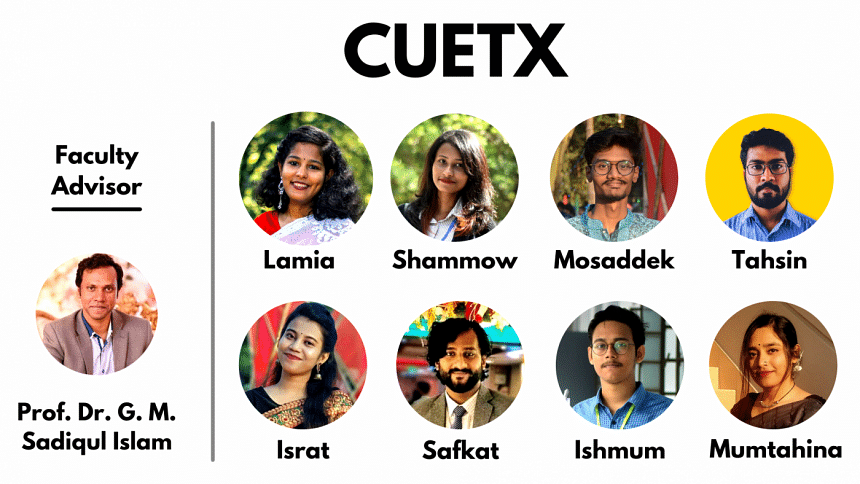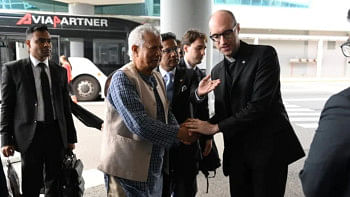CUET students propose solution to combat river erosion at ACI Spring Convention

River erosion is a pressing issue in our country. The Padma River's water constantly shifts and transforms the shape of the river, which is eventually eating away at its bank. To minimise the damage, the river is sometimes governed by sandbags and concrete blocks made from cement — but that is far from a solution, as it imposes threat to the environment by increasing the emission of carbon dioxide.
To ensure an eco-friendly and more sustainable solution to it, CUETX, a team of eight students from the Civil Engineering Department of from Chittagong University of Engineering and Technology, (CUET), proposed a sustainable and cost-effective solution, and showed that it is possible to make concrete blocks using industrial, construction and demolition waste like fly ash, slag, and brick dust. They named the element made from these recycled materials Recycled Geopolymer Concrete Block.
The members of team CUETX are Lamia Islam Leeya, Aneeca Farzana, Tahsin Mahmud, Md Mosaddek Hameem, Israt Jahan, Safkat Ar Rumman, Md Mahtab Ishmum and Mumtahina Mumu and their faculty advisor Prof Dr G M Sadiqul Islam.
The team participated in ACI Concrete Solution Competition, Spring 2021, organised by American Concrete Institute, an international construction policy-making body. They have secured the third place globally.
The team has been preparing to attend the ACI Spring Convention since the beginning of the year. They organised an inter-university competition called 'Concrete Solution Competition' at the university on February 1 to send the best team to the international round. CUETX was selected from there.
Israt Jahan, one of the team members said they came to know about the competition from a Facebook post. She said, "In February 2021, ACI Student Chapter, CUET organised Intra University Concrete Solution Competition, from where the first two selected teams got a chance to form their own team to represent CUET internationally. Eventually, our team 'CUETX' was formed."
The team started working on the geo-polymer concrete block from day one to prepare for the international round. Lamia Islam, a member of the team, said the main difference between conventional concrete blocks and geo-polymer blocks is its binding material. Sodium hydroxide or potassium hydroxide and sodium silicate are used in geo-polymer blocks and comes with a source of aluminum silica as fly ash, slag, and construction waste. Compared to cement, these components do not have any harmful side effects. Lamia thinks that if this method is used, there will be an opportunity to prevent river erosion as well as to utilize construction waste and industrial waste.
The convention began on March 26 with 250 universities registered in Farmington Hills, Michigan, headquartered in Michigan. The finale took place on March 28, online. On March 23, CUETX first took place in the top 20 teams. The ACI judges interviewed the team members online on March 26. On March 30, CUETX was announced as the second runner-up, and their idea was welcomed by the American Concrete Institute (ACI).
"This fascinating use of waste materials in concrete makes our idea a huge potential for upcoming use of riverbank protection beyond. If we are successful in using this practically, we can see a solution which will not only reduces our use of cement, a material with huge carbon footprint, but also reduce our dependence and exploitation of natural sand and stones. As our concrete is mostly waste materials, it can be an economical alternative to concrete blocks which are currently used now," says Lamia. CUETX believes that with proper convenience and chance, their innovation can prove to be a big asset in protection of riverbanks in the future.
"As a student of Civil Engineering, this is a huge achievement for us. I am thrilled to be a part of this team under the banner of CUET, and representing Bangladesh," says Aneeca Farzana. "The idea that brought us success has a long way to go and the eight of us along with our advisor are looking forward to taking it to the next level."
Advisor GM Sadiqul Islam says, "Since 2024, about 10 metric tons of fly ash will be generated annually from coal power plants. We do not have the power to recycle it. Since geo-polymer concrete blocks can be made from fly ash, it will enable us to manage waste and help us manage river erosion at the same time. This will ensure the possibility of a positive role in achieving Sustainable Development Goals."
For securing the third place, the American Concrete Institute (ACI) will give each member of CUETX a certificate as a team. The university's Vice-Chancellor Rafiqul Alam says, "Such an award is proof of the research we do. The CUET family is very happy and proud of the students' success."

 For all latest news, follow The Daily Star's Google News channel.
For all latest news, follow The Daily Star's Google News channel. 



Comments